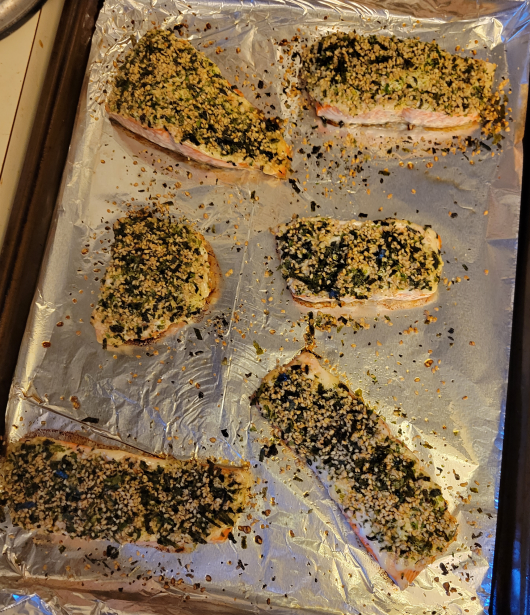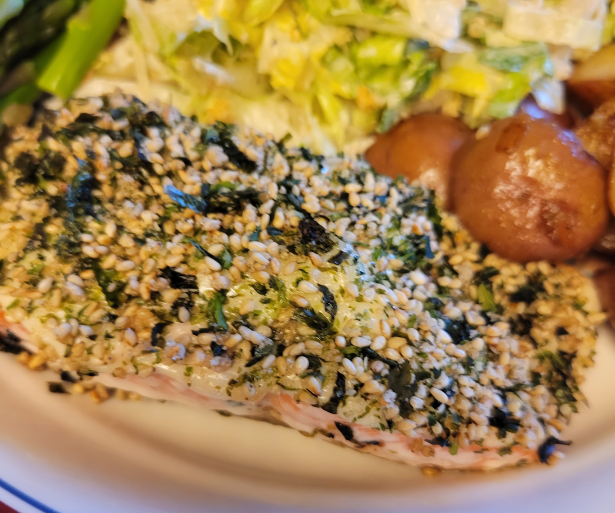KC 314 - Furikake Salmon

Why hello there, and welcome back to Kitchen Catastrophe, where every week just enough goes wrong that Jon never feels content or satisfied. I’m your Author-Most-Likely-To-Die-To-Aaron-Burr, Jon O’Guin, and today’s recipe is very simple. SO simple, in fact, that the only real reason I’m covering it as its own post is that it serves as a nice way for me to say Happy Birthday to my brother, Stephen, without whom this dish would have been marginally less good and impressive. So Happy Birthday, and if you all want to jump straight to the recipe, you can with this link, while I try and brew a tempest in a teapot to keep this post somewhat interesting.
Let’s Get The Yardwork Out of the Way
First, though I’d like to credit the author (as far as I know) of the recipe, Koa Feliciano de Silva, a person I don’t think I’ve ever met*. (I have been informed that belief was correct.) Normally, that would be assumed, but it’s mildly relevant for this conversation since today’s recipe comes not from a blog, website, or commercial cooking publication, but rather a cookbook comprised of recipes taken from the Pennsylvania ERP Team, which my mother works on. If you don’t know what that means, a “mother” refers to the parent of the child who identifies as female, often referring to the parent who gave birth to the child in question. If you don’t know what the EARLIER stuff meant, allow me to explain, hopefully in a way that doesn’t technically count as me committing treason.
Which is only a MILD concern, but it does exist whenever talking about my mom’s (and formerly my dad’s) work: they do work for the Department of Defense, on nuclear naval vessels, so I do have a better-than-most understanding of the relative movements, status, and issues for a fair number of our most powerful vessels, and there’s a mild amount of “Am I supposed to know detail X?”
Listen, if you’re using me to spy on the US military, I am a low-value asset at best.
Unless my value determines whether you execute me or not. Then I know a ton. So much. So much…boat stuff.
In this instance, we are protected by jargon as, when asked, my mother can’t even tell me what ERP stands for: she knows the “R” stands for “Re-fit”, and the term as a whole means something like (again, some amount of waffling or imprecision is normal) “this is a short window of work/not a regularly scheduled window.” If that sounds worrisome, it helps to scale it down: you know how you’re supposed to get your car tuned up at specific intervals? Like, every 6,000 miles you should get your oil changed, and rotate your tires, every 30 you should replace your brake fluid and filters, every 50-60,000 you should think about your battery, transmission fluid, brake PADS, coolant, etc etc. The same thing applies to ANY big moving machine. Trucks, cranes, ships, submarines, etc. On the other hand, sometimes your car just feels like it needs a tune-up, or you’ve got some spare time before a trip, so you take it into the shop as a “just-in-case”. THAT is closer to what an ERP is, by the 10 second explanation I received: roughly the submarine equivalent of popping into the Les Schwab because one of the wheels is making noise on the highway.
The cookbook produced by the team is...well, it’s hard to describe, in that sort of Foster Wallace “What is Water” way: to me, the cookbook makes perfect sense, because I grew up in Port Orchard, waist deep in the cultural and economic effects of the Shipyard, which I think I’ll talk more about on Thursday, but for now can be summed up as “middle-class and mildly multi-cultural with a “just-above-blue-collar” vibe” Like, I am used to a mix of names associated with various ports and bases around the world, from Germanic/Scandinavian (Olsen, Wagner, etc) to Asian (Nguyen, Nakamoto, etc), and Hispanic/Filipino (De Silva, De La Cruz, Hernandez), and I am used to all of those families making tuna casserole, for some reason.
Welcome to America, where we will feed you beige meat and starch mixtures until we figure out which of your culture’s foods we like, at which point we will make them with the spices all wrong.
So the cookbook having like, two recipes for mac-and-cheese, two for chili, one for chicken tinga taquitos, and one for furikake salmon is just…how things are, around here. Thus it is that, while my mother may not be all that aware of furikake, or able to consistently pronounce it, the recipe was something recognizable and appealing to our family. Especially since we had quite the assortment of salmon to work through, thanks to Stephen.
Weigh Anchors, Lads.
Basically, a couple months ago, Stephen reached out about an opportunity: he had learned about a group that was doing sustainable salmon fishing by, essentially, pre-selling shares. You placed an order with them for X pounds of salmon, and when they went fishing for the season, they caught as many pounds as they had pre-sold, so that there was no excess harvest.
The make sure everyone gets their…fill-et.
As such, we ended up with…I think 20 pounds of salmon? Let me try and find the website…let me text Stephen to tell me the website…(Look: my distaste for seafood is fairly well documented, so this entire enterprise was a “those guys” thing for most of the plan time) ah, here we go, he says it’s Iliamna Fish Company…Alright, their shares are 21 pounds. That sounds right, and the website looks vaguely familiar. I remember there was some confusion over the amount of salmon, because we were splitting the share between Stephen and Anna, and our household, but I didn’t really check in until Stephen mentioned that they were going to take their fresh salmon, and get some it smoked and peppered, at a local (to them) place. For some reason (likely the relatively processed nature, and ubiquity in my region), smoked salmon and canned tuna fish were the two primary long-standing exceptions to the “I don’t eat fish” rule.
And…I honestly thought I’d have more to say about this section, but turns out I was more efficient than I thought. E-fish-ent? Gross. So I guess we’ll just move on to the main event.
Ship-Shape Salmon Bake
Furikake salmon is, according to 45 seconds of research, predominantly a Hawaiian dish, representing (as so much of Hawaiian food does) a fusion of American/Western ideas with Japanese/Asian ones. Specifically, furikake is a Japanese condiment for rice and fish that we’ve talked about before. The mixture is often sprinkled over a bowl of rice or strips of fish over rice. With this dish, it’s treated more as almost a breading for oven-baked salmon filets, forming a compact layer on the top of the fish to help shield it from the top heating element of the oven.
“Is that what my purpose is?”
The dish is sometimes served as is, or is flaked and served in hand-rolls, but we decided to go with the whole cuts. So, how do you make this? Well, that depends on how authentic you want to be/hard you want to work. Because if you don’t make your own furikake, this is a three-ingredient, 4 step, 10-20 minute recipe, depending on your salmon.
Indeed, if you have kids who like fish or fishy foods, this would be an excellent recipe to get them interested in cooking, because two of the 4 steps are “cover top of salmon with next ingredient”. First, you coat the top of the fish with a layer of mayonnaise.
I will acknowledge that “a layer of mayonnaise” is a worrying phrase outside of sandwich construction.
Then, on top of the mayonnaise (which, like the furikake, will help absorb heat, keeping the fish more tender, and, unlike the furikake, adds fat and richness to the dish.) you add a layer of furikake.
Real talk: I didn’t check the time on this picture, so I don’t know if this is pre or post baking. I think pre, but hard to tell.
Then you bake it. That’s it. The fourth step was the preparatory “turn on your oven, and line a baking sheet with foil”. So the full recipe is “prep cooking tools, coat salmon, coat salmon, bake salmon.” It’s little wonder the recipe’s popular, it’s arguably easier than peanut butter and Jelly sandwiches!
Admittedly longer, unless you’re VERY bad at spreading toppings.
The results are fine. Again, I am not a lover of seafood, but the salmon is still moist, the furikake adds some vital texture, and a bit of complexity and seasoning (which, if you want to get wild, you can vary by using different furikake blends. We ALMOST did one with flakes of sweetened egg in it, because we didn’t initially understand the difference between the two blends we got.) I also saw a different version of this recipe where you mix in some wasabi paste to the mayo before spreading, which would certainly spice things up. I saw another where they grated garlic into the mayo. In general, if you like salmon/sushi, I think this would probably be something you’d like to try. Furikake can probably be found in the Asian food section of your local supermarket, and if not, there’s plenty of online suppliers to check out. So happy birthday once more to the brother who made this meal possible, and I’ll talk to you all more on Thursday/Friday.
THURSDAY: JON TALKS ABOUT THE CULINARY AND CULTURAL SCENE OF HIS HOMETOWN, SINCE APRIL IS NOT JUST HIS MIDDLE BROTHER’S BIRTH MONTH, BUT ALSO HIS YOUNGEST BROTHER’S.
MONDAY: MAYBE WE TRY BAKING SOME QUICK BREADS TO KEEP EASTER EASY
Recipe
Furikake Salmon
Makes however much you want, because this recipe doesn’t come with proportions.
Ingredients
Salmon filet
1-2 tsp Mayonnaise per salmon filet if individually sized, enough to coat if a whole filet
~1-1.5 tbsp furikake per filet if individually sized, or enough to coat
Preparation
Preheat your oven to 400. Line a rimmed baking sheet with foil. Lightly grease foil.
Pat salmon dry with a paper towel, and place skin-side down on foiled sheet. Cover tops of filets with mayonnaise.
Sprinkle Furikake over salmon.
Place in oven, and bake until done (8-12 minutes if individually sized, 18-22 if a whole filet).
Serve with rice and soy sauce, and add some mac salad if you wanna go plate lunch.












